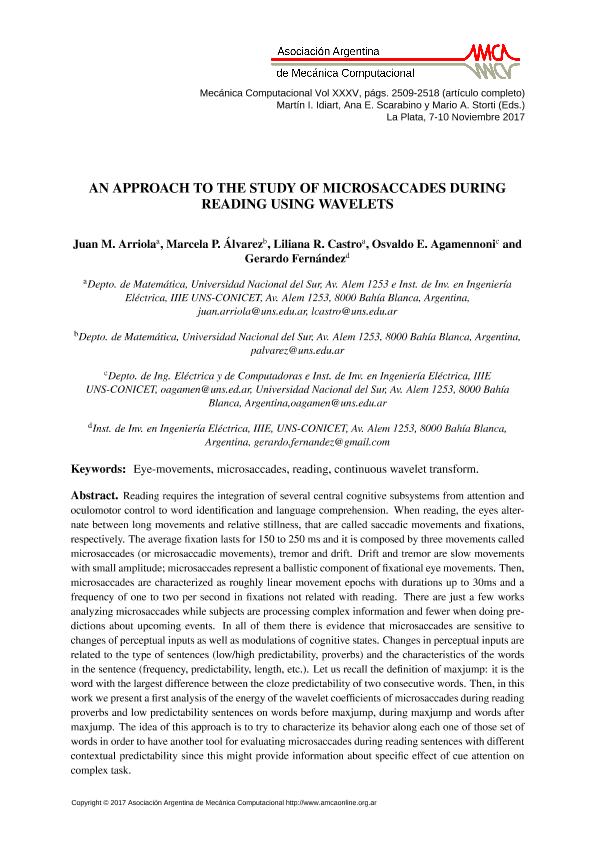Mostrar el registro sencillo del ítem
dc.contributor.author
Arriola, Juan Manuel

dc.contributor.author
Alvarez, Marcela Patricia

dc.contributor.author
Castro, Liliana Raquel

dc.contributor.author
Agamennoni, Osvaldo Enrique

dc.contributor.author
Fernández, Gerardo Abel

dc.date.available
2019-10-18T20:22:12Z
dc.date.issued
2018-03
dc.identifier.citation
Arriola, Juan Manuel; Alvarez, Marcela Patricia; Castro, Liliana Raquel; Agamennoni, Osvaldo Enrique; Fernández, Gerardo Abel; An Approach to the Study of Microsaccades during Reading Using Wavelets; Asociación Argentina de Mecánica Computacional; Mecánica Computacional; XXXV; 43; 3-2018; 2509-2518
dc.identifier.issn
2591-3522
dc.identifier.uri
http://hdl.handle.net/11336/86494
dc.description.abstract
Reading requires the integration of several central cognitive subsystems from attention and oculomotor control to word identification and language comprehension. When reading, the eyes alternate between long movements and relative stillness, that are called saccadic movements and fixations, respectively. The average fixation lasts for 150 to 250 ms and it is composed by three movements called microsaccades (or microsaccadic movements), tremor and drift. Drift and tremor are slow movements with small amplitude; microsaccades represent a ballistic component of fixational eye movements. Then, microsaccades are characterized as roughly linear movement epochs with durations up to 30ms and a frequency of one to two per second in fixations not related with reading. There are just a few works analyzing microsaccades while subjects are processing complex information and fewer when doing predictions about upcoming events. In all of them there is evidence that microsaccades are sensitive to changes of perceptual inputs as well as modulations of cognitive states. Changes in perceptual inputs are related to the type of sentences (low/high predictability, proverbs) and the characteristics of the words in the sentence (frequency, predictability, length, etc.). Let us recall the definition of maxjump: it is the word with the largest difference between the cloze predictability of two consecutive words. Then, in this work we present a first analysis of the energy of the wavelet coefficients of microsaccades during reading proverbs and low predictability sentences on words before maxjump, during maxjump and words after maxjump. The idea of this approach is to try to characterize its behavior along each one of those set of words in order to have another tool for evaluating microsaccades during reading sentences with different contextual predictability since this might provide information about specific effect of cue attention on complex task.
dc.format
application/pdf
dc.language.iso
eng
dc.publisher
Asociación Argentina de Mecánica Computacional
dc.rights
info:eu-repo/semantics/openAccess
dc.rights.uri
https://creativecommons.org/licenses/by-nc-sa/2.5/ar/
dc.subject
EYE MOVEMENTS
dc.subject
MICROSACCADES
dc.subject
READING
dc.subject
WAVELET TRANSFORM
dc.subject.classification
Matemática Aplicada

dc.subject.classification
Matemáticas

dc.subject.classification
CIENCIAS NATURALES Y EXACTAS

dc.title
An Approach to the Study of Microsaccades during Reading Using Wavelets
dc.type
info:eu-repo/semantics/article
dc.type
info:ar-repo/semantics/artículo
dc.type
info:eu-repo/semantics/publishedVersion
dc.date.updated
2019-10-15T13:37:19Z
dc.journal.volume
XXXV
dc.journal.number
43
dc.journal.pagination
2509-2518
dc.journal.pais
Argentina

dc.journal.ciudad
Santa Fe
dc.description.fil
Fil: Arriola, Juan Manuel. Consejo Nacional de Investigaciones Científicas y Técnicas. Centro Científico Tecnológico Conicet - Bahía Blanca. Instituto de Investigaciones en Ingeniería Eléctrica "Alfredo Desages". Universidad Nacional del Sur. Departamento de Ingeniería Eléctrica y de Computadoras. Instituto de Investigaciones en Ingeniería Eléctrica "Alfredo Desages"; Argentina
dc.description.fil
Fil: Alvarez, Marcela Patricia. Universidad Nacional del Sur. Departamento de Matemática; Argentina
dc.description.fil
Fil: Castro, Liliana Raquel. Consejo Nacional de Investigaciones Científicas y Técnicas. Centro Científico Tecnológico Conicet - Bahía Blanca. Instituto de Investigaciones en Ingeniería Eléctrica "Alfredo Desages". Universidad Nacional del Sur. Departamento de Ingeniería Eléctrica y de Computadoras. Instituto de Investigaciones en Ingeniería Eléctrica "Alfredo Desages"; Argentina
dc.description.fil
Fil: Agamennoni, Osvaldo Enrique. Consejo Nacional de Investigaciones Científicas y Técnicas. Centro Científico Tecnológico Conicet - Bahía Blanca. Instituto de Investigaciones en Ingeniería Eléctrica "Alfredo Desages". Universidad Nacional del Sur. Departamento de Ingeniería Eléctrica y de Computadoras. Instituto de Investigaciones en Ingeniería Eléctrica "Alfredo Desages"; Argentina
dc.description.fil
Fil: Fernández, Gerardo Abel. Consejo Nacional de Investigaciones Científicas y Técnicas. Centro Científico Tecnológico Conicet - Bahía Blanca. Instituto de Investigaciones en Ingeniería Eléctrica "Alfredo Desages". Universidad Nacional del Sur. Departamento de Ingeniería Eléctrica y de Computadoras. Instituto de Investigaciones en Ingeniería Eléctrica "Alfredo Desages"; Argentina
dc.journal.title
Mecánica Computacional

dc.relation.alternativeid
info:eu-repo/semantics/altIdentifier/url/https://cimec.org.ar/ojs/index.php/mc/article/view/5465
Archivos asociados
